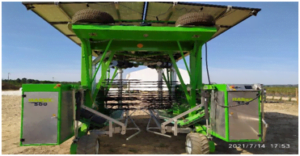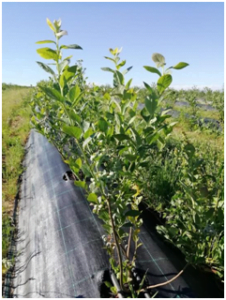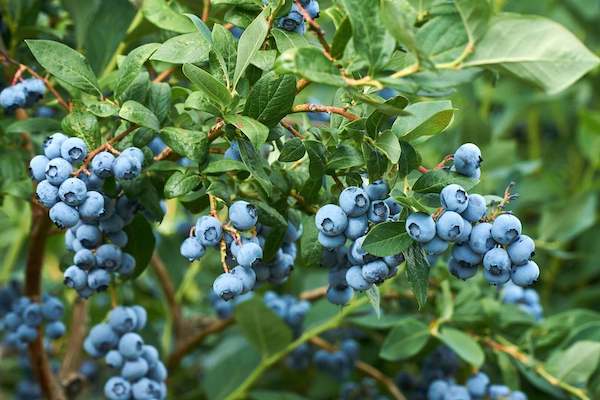Jorge Duarte, a Portuguese agronomist who advises berry growers, was hired by USAID’s agriculture program in Georgia to advise local growers. After a series of online seminars in 2020, he visited berry plantations in Georgia twice in April and July 2021. Since Jorge has extensive experience working with berries in Morocco, Egypt, Romania, Spain, Italy, Turkey, EastFruit Georgian experts discussed the current state and prospects of blueberry production in Georgia with him.
– What was your first impression of the blueberry sector in Georgia?
– In July, I visited several small and large blueberry plantations in the Guria region. Large blueberry farms in Portugal are rare, on average they do not exceed 2 hectares. Blueberries are a very labor-intensive crop – it can take 25 people to harvest one hectare. As more plantations are established, producers are facing labor shortages now. And this will continue in the future due to competition between various sub-sectors and companies. The same thing happened in Portugal, which led to the mechanization of some processes such as pruning. Harvesting is still done manually. After spending one week in orchards in Georgia, I can conclude that the level of mechanization is low or absent.
– Georgian producers believe that manual picking helps to preserve the high quality of berries and thus they sell better on the fresh market, what can you say about this?
– This is true throughout the world, not only in Georgia. But it is relevant only when growing old varieties, as in Georgia. The main producing countries are now planting new varieties that are more resistant and adapted to mechanical harvesting. Cultivation of new varieties is now a trend in Portugal as well, growers started planting them 3-4 years ago. However, the area planted with new varieties in Georgia is small. Georgian growers should get acquainted with modern varieties suitable for mechanized harvesting, as they will face even more shortage of labor for manual harvesting in the future.

– Which varieties are suitable for mechanical harvesting?
– You can mechanize harvesting on any blueberry farm, but the percentage of damaged fruits will vary. The goal of mechanical harvesting is to harvest high quality berries with less losses. For milder varieties such as New Hanover, Star or even Legacy, which can also be soft in extreme temperatures, it will be difficult to use machines without getting a lot of softer berries. This is not recommended, but still possible if a producer can handle a higher waste rate. One of the best varieties for mechanical harvesting is Duke, a High Chill variety. There are also good Mid Chill and Low Chill varieties, such as Top Shelf, Blue Ribbon and Suziblue.
For mechanized harvesting, areas should be planted with blueberries in a pattern that allows to harvest and trim bushes properly. All this should be considered before planting. As far as I know, there are no blueberry plantations in Georgia suitable for mechanized harvesting now.
– Can existing plantations be adapted for mechanical harvesting?
– The main peculiarity of the planting scheme is the distance between rows and pruning. Plants should be pruned so that they grow straight and do not open. It is necessary to remove low branches and prepare the plants for mechanical harvesting. The resistance of fruits to mechanical harvesting, as well as distance between the plants are also important. The machines on the market are designed for a row spacing of 2.5-3 meters.

It is possible to adapt existing harvesters, or you can find smaller machines that can be attached to your tractor. Finefields from the Netherlands and Tresac from Serbia are known in this market.

– Are Georgian farmers ready now for these changes?
– I think that farmers are now busy with other issues such as commercialization, having enough people to harvest and the quality of products. Other challenges relate to studying the use of a cooling system to maintain quality and improve irrigation management. Irrigation is not well designed in terms of the number of drippers per meter, which interferes with good water distribution around the root zone. Producers should take into account that blueberries have a very shallow root system. It is mostly 20 cm deep and plants need a lot of water in the spring and summer. Some of the producers I have seen have installed inefficient irrigation systems.
Another aspect growers should pay attention to is fertilization and soil improvement. The soil in the region of Guria is rich in clay – 50-70%, which is bad for blueberries. The soil for blueberries should be light so that water can penetrate well. I have seen too heavy soils and insufficient soil improvement work (correct weed removal, improving natural soil drainage with rippers, increasing/decreasing soil pH with lime or sulfur, adding extra organic matter to improve rooting, etc.). For tall ridges, I would recommend 40 cm high and 90-100 cm wide, which is very important for oxygenating the root system and improving water distribution. There were several successful growers, but they did it at a rough guess.
It is also important to plan your blueberry plantation in advance. Modern farmers cannot wait two or three years to start harvesting. They must harvest the first crop of berries one year after planting, at least 0.5 kg to 1 kg per plant, for which high quality planting material is needed. The market sells annual and biennial blueberry seedlings. Most nurseries plan to grow annuals rather than biennials as biennials require more space, resizing pots, and additional substrates, which makes seedlings more expensive. Biennial plants are usually used in climates with a shorter growing season than in Northern Europe.
Many farmers in Georgia plant in winter rather than spring, but spring is better because of higher temperatures and better light so that the plants grow and develop the root system faster. Another issue is ordering plants on time, at least 1,5 years before planting. If one thinks about planting in 3 months, he risks buying second-class seedlings from nurseries, mostly leftovers. In nurseries, seedlings are planted by in vitro propagation (common) or stem cuttings (currently less common) with sufficient time (3-6 months) before they grow in 1L, 1.5L or 2L pots that are used often.
Nurseries and growers can both benefit if they know in advance what to supply (varieties, quantity and type of plants), leading to improved service and quality of purchased plants. With that said, I believe that any blueberry plantation project should be planned at least 2 years in advance, not 6 months as I saw in Georgia.
– What can be the solution for plantations that grow poorly?
– If the plants do not start to grow well a year or two after planting, it is better to remove them from the field and replant. I quote Dave Brazelton, who is very well skilled in blueberries, who said, “You have two years to love blueberries and your whole life to hate them.”
If farmers do not cope with the planting material and soil preparation, they will not be successful enough with this crop, especially on such heavy soils, as I have seen in the Guria region, so they must do everything well.
The climate in the Guria region seems to be quite suitable for growing blueberries, but the soil has some issues, such as a high percentage of clay, which is not recommended, but still can be used to grow blueberries.
As I read in one of your publications, blueberry plantations have existed in Georgia since 2012. Nowadays, when the market is very demanding, growers should focus on improving plantation design, soil and irrigation system characteristics, gaining basic knowledge of the operations, both pruning, and continuing a good and sustainable soil and plant fertilization program.
To summarize, as I understand it, large companies have already learned some of these lessons from their own mistakes, and now new producers must learn that. I also believe that blueberry growers could benefit from joining forces to improve communication with each other, learn from others and create a true blueberry industry in Georgia that is new and dynamic and could be an important newcomer to the export market.
The use of the site materials is free if there is a direct and open for search engines hyperlink to a specific publication of the East-Fruit.com website.




